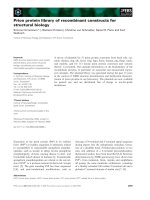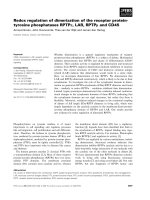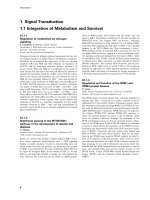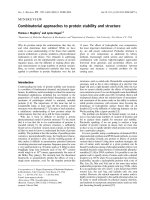Structural genomics and structural biology: compare and contrast pdf
Bạn đang xem bản rút gọn của tài liệu. Xem và tải ngay bản đầy đủ của tài liệu tại đây (57.85 KB, 4 trang )
Genome Biology 2004, 5:343
comment
reviews
reports
deposited research
interactions
information
refereed research
Meeting report
Structural genomics and structural biology: compare and contrast
John-Marc Chandonia*, Thomas N Earnest
†
and Steven E Brenner*
‡
Addresses: *Berkeley Structural Genomics Center and
†
Physical Biosciences Division, Lawrence Berkeley National Laboratory, Berkeley,
CA 94720, USA.
‡
Department of Plant and Microbial Biology, 461A Koshland Hall, University of California, Berkeley, CA 94720-3102, USA.
Correspondence: Steven E Brenner. E-mail:
Published: 25 August 2004
Genome Biology 2004, 5:343
The electronic version of this article is the complete one and can be
found online at />© 2004 BioMed Central Ltd
A report on the Keystone Symposium ‘Structural Genomics’,
held concurrently with the ‘Frontiers in Structural Biology’
symposium, Snowbird, USA, 13-19 April 2004.
Is structural genomics a visionary undertaking heralding the
future of structural biology, or merely a billion-dollar-plus
folly? Two concurrent Keystone Symposia, ‘Structural
Genomics’ and ‘Frontiers in Structural Biology’, brought
together leading structural biologists and pioneers of the
structural genomics community, providing an exciting oppor-
tunity to contrast cutting-edge advances in the two fields. The
advances in structural genomics have focused on providing
value for money: improved automation has resulted in
expanded productivity. We expect the resulting flood of struc-
tures to provide an essential platform for future biological
and medical research - just as genome-sequencing projects
enabled new avenues of research, for example on the non-
coding regions of DNA. In contrast, recent structural biology
work has provided a tremendous amount of detail on specific
biological mechanisms, including many areas that were pre-
viously beyond our technological capabilities to study.
Results from structural genomics consortia
In the US, the National Institutes of Health (NIH) are cur-
rently sponsoring nine pilot structural genomics centers
through the Protein Structure Initiative (PSI). These centers
are developing and deploying high-throughput techniques
in preparation for the production phase of the PSI, set to
begin in 2005. Gaetano Montelione (Northeast Structural
Genomics Consortium (NESGC) and Rutgers University,
Piscataway, USA) described the accelerating pace of struc-
ture determination in structural genomics. His center pro-
duced 9 structures in 2001 but it is currently on track to
produce 75 structures in 2004; similar scaling up is
reported by most other centers. The NESGC has success-
fully developed software to recognize innaccurate structures
automatically, and to speed up the solution of structures by
nuclear magnetic resonance (NMR) spectroscopy through
automatic assignment of peaks on the NMR spectrum to
atoms in the structure. The NESGC has also set up an auto-
mated pipeline to annotate proteins of known structure but
unknown function.
The push towards high-throughput structure determination
has shown the most impact initially on the automation of
cloning, expression, and purification of proteins. Represen-
tatives from various PSI centers described efforts to estab-
lish an automated pipeline all the way from selection of the
‘target’ protein whose structure is to be solved, through to
deposition of the solved structure in the Protein Data Bank
(PDB [ Scott Lesley (Joint
Center for Structural Genomics (JCSG), San Diego, USA)
and Spencer Emtage (Structural Genomix, San Diego, USA)
described the automated technology that their teams have
developed for protein production: their multi-tiered
approach handles the more tractable targets quickly and
then applies increasingly specific approaches to the less
tractable targets. The speakers who addressed protein pro-
duction described primarily the adaptation of commercial
robots to automate tasks; the main lesson is that one needs
to multiplex as much and as early as possible in creating
constructs, vectors, hosts, tags, purification schemes, and so
on. With the added complexity, information management
becomes particularly important. In contrast, Cheryl Arrow-
smith (Structural Genomics Consortium (SGC) and Ontario
Cancer Institute, Toronto, Canada) described how the SGC
has deployed an effective pipeline with only limited use of
robotics; too much automation has the danger of overly lim-
iting experimental flexibility and especially the ability to
adapt new protocols.
Automation of data collection for structures determined by
X-ray crystallography has proven to be a success. Peter Kuhn
(JCSG and Scripps, La Jolla, USA), Andrzej Joachimiak
(Midwest Center for Structural Genomics (MSGC) and
Argonne National Laboratory, Argonne, USA), and one of us
(T.E.) described systems to automate and integrate the steps
of crystal screening, data collection and processing, resulting
in overall increases in both speed and accuracy of structure
determination. Kuhn also described the early development
of a nanocalorimeter that offers the possibility of experimen-
tal exploration of protein-protein and protein-ligand interac-
tions with samples as small as a nanoliter. As the
crystallization of protein targets remains a bottleneck,
Rebecca Page (JCSG and Scripps Research Institute, San
Diego, USA) described how high-throughput systematic
crystallization trials at the JCSG have resulted in a database
of over 325,000 crystallization experiments, which are being
mined to identify proteins that crystallize more readily. Page
showed that some biophysical properties of proteins - such
as an unusually large or small Grand average of hydropathic-
ity (Gravy) index, which correlates with solubility, or low
complexity regions predicted by the SEG program - correlate
well with crystallization difficulties. While the results are not
unexpected, this is one of the first experimental studies to
prove this correlation, and it enabled the JCSG to eliminate
35% of their potential targets without reducing their produc-
tion of structures. Wim Hol (Structural Genomics of Patho-
genic Protozoa (SGPP) and University of Washington,
Seattle, USA) promoted the advantages of microcrystalliza-
tion trials in plastic capillaries. These capillaries provide
conditions similar to hanging-drop crystallization trials; but,
as the plastic is nearly invisible to X-rays, freezing and data
collection proceeds without removing the crystals from the
capillary, avoiding the need for crystal handling.
Analysis of structures from structural genomics
An important goal of structural genomics is to annotate pro-
teins of unknown function, primarily through analysis of
their structures. Janet Thornton (MCSG and University
College London, UK) described numerous methods for
assigning function from structure, including inference of
remote homology relationships, identification of ligands, and
locations of electrostatic patches, pockets, and evolutionarily
conserved residues; these methods are implemented in the
ProFunc pipeline. Function may also be determined using
high-throughput biochemical screens even in the absence of
structure: Cheryl Arrowsmith described an array of binding
assays that are used to determine whether each of a standard
set of ligands binds to every protein purified by the SGC.
Function may also be predicted by inferring homology from
structure. Juswinder Singh (Biogen-Idec, Cambridge, USA)
described methods for mining databases of the topologies of
proteins with disulfide bonds to identify remote evolutionary
relationships between proteins. Singh also presented the
SIFTS database of structure-interaction fingerprints derived
from known structures of ligand-receptor interactions,
which his colleagues have successfully used to perform
‘virtual screening’ of potential ligands.
To ensure the quality of structures produced by their
centers, Gaetano Montelione and Jane Richardson (South-
east Collaboratory for Structural Genomics (SECSG) and
Duke University, Durham, USA) described automated tools
(Procheck, MAGE, and MolProbity) they have deployed to
reduce the number of errors. Procheck [http://www.
biochem.ucl.ac.uk/~roman/procheck/procheck.html] checks
the overall stereochemical quality of a protein structure; Mage
[ />is an interactive program for displaying proteins; and Mol-
Probity [ />index.html] is a graphical user interface to several other
structure-validation tools developed by the Richardson lab.
Janet Thornton also pointed out the relatively large diversity
of structures solved by structural-genomics centers, com-
pared with all the structures deposited in the PDB over the
same time period: although 62% of all structures recently
deposited in the PDB have a near-identical match already in
the PDB, 63% of structures determined by structural
genomics have no matches detectable from sequence.
Thornton found that 14% of structures solved by structural
genomics had new folds in the CATH protein structure clas-
sification database [ />cath/], 9% belonged to new superfamilies within existing
fold classes, and 77% belonged to existing superfamilies. The
lengths and domain organizations of structural-genomics
targets were also distributed similarly to all other PDB entries.
The future of structural genomics
John Norvell (National Institute for General Medical Sci-
ences, NIH, Bethesda, USA) presented details of the request
for applications for the next phase of the PSI, which will start
in July 2005. The PSI-II will consist of three or four major
components: large-scale centers, which will focus on high-
throughput production of structures aimed at increasing the
structural coverage of proteins from sequenced genomes;
specialized centers that will focus on eliminating the remain-
ing barriers to high-throughput structure solution of chal-
lenging proteins (such as integral membrane proteins and
multiprotein complexes); a centralized ‘knowledge base’ to
disseminate results to the public, as well as to coordinate
the target lists for each center; and (pending availability of
funds from other NIH centers) disease-related centers that
will focus on pathogenic genomes and on proteins from
tissues and organs related to disease. Additional funds for
biochemical analysis of structures will be available through
supporting grants.
Several speakers suggested strategies for directing resources
in the next phase of structural genomics. Before presenting
343.2 Genome Biology 2004, Volume 5, Issue 9, Article 343 Chandonia et al. />Genome Biology 2004, 5:343
recent advances in NMR technology that enable larger struc-
tures to be solved, Kurt Wuthrich (JCSG and Swiss Federal
Institute of Technology, Zurich, Switzerland) recommended
selecting targets that provide complete coverage of several
small proteomes and supplementing these targets with
human and mouse proteins as well as membrane structures.
Andrej Sali (NESGC and University of California, San Fran-
cisco, USA) recommends that structural genomics focuses
on maximizing the number of structures that can be
modeled with useful accuracy by computational methods.
Christine Orengo (MCSG and University College London,
UK) recommended focusing broad coverage on the largest
1,345 protein families in the Pfam database [http://
www.sanger.ac.uk/Software/Pfam/] with no structural rep-
resentative, with finer coverage used sparingly to probe
medically relevant families and unexplored regions of func-
tion space in sequenced proteomes. Orengo also presented
unpublished data showing that although functional annota-
tions based on single domains are generally unreliable below
40% sequence identity, annotations of a single protein based
on combinations of multiple domains are accurate when
based on as little as 20% identity. We (J M.C. and S.E.B.)
quantified the ‘Pfam 5,000’ [ />chandonia-2004-proteins-pfam5000.pdf], a strategy to
solve the structures of proteins from the largest Pfam fami-
lies. This strategy would have a broad impact on our struc-
tural interpretation of sequenced proteins: obtaining the
structure of one target from each of the 5,000 largest Pfam
families would enable accurate fold assignment for approxi-
mately 68% of all prokaryotic proteins (covering 59% of
residues) and 61% of eukaryotic proteins (40% of residues).
We expressed the view that although the strategy of focusing
structural genomics on a single tractable genome would have
intrinsic benefits for our understanding of that organism, it
would have little impact on our ability to interpret protein
structures from other organisms.
Structural biology highlights
While structural genomics has become large-scale by increas-
ing the throughput of structure production, structural biology
has also become large-scale through advances that extend the
range of structural biology to exploration of large macromole-
cular assemblies, real-time visualization of protein motions,
single-molecule studies, and studies of ribozymes. Steve Har-
rison (Harvard University, Cambridge, USA) set the tone for
the structural biology talks by describing the elegant interplay
of several techniques - such as combining data from low-
resolution electron microscopy with high-resolution X-ray
crystallography, and real-time movies of live cells stained with
immunofluorescent markers - to elucidate details of clathrin
coat assembly and disassembly. The clathrin structure illus-
trates the importance of protein folding and unfolding in
macromolecular assembly, as key components of the disas-
sembly process are chaperone-related proteins. Harrison
predicted that structural biology will tend towards more
interactive experimentation in the future.
Three other speakers described technological advances in
structural biology. David Agard (University of California,
San Francisco) discussed the use of spatially structured illu-
mination to extend the resolution limits of optical wide-field
microscopy to better than 100 nm, with the promise of even
higher resolution. Bridget Carragher (Scripps Research
Institute) described how automated electron microscopy can
be used to assemble medium-resolution structures of bio-
molecular assemblies from thousands of low-dose images.
Homme Hellinga (Duke University Medical Center, Durham,
USA) reported his group’s remarkably successful efforts to
computationally engineer the functions of a biologically
active protein. One application of this work has been
reagentless sensors, which combine ligand-binding and
reporter functions in a single molecule. Hellinga also used a
combination of computational design and directed evolution
to swap the functions of two active enzymes using scaffold-
ing from the other’s (very different) folds.
Susan Marqusee (University of California, Berkeley, USA)
has surveyed the Escherichia coli proteome to determine
which proteins resist proteolysis, finding that resistance is
not a result of the overall shape, rigidity, or thermodynamic
stability of the native fold, but instead is a property of the
energy landscape and whether the protein folds into near-
native states with locally unfolded regions. Finally, two
studies of individual macromolecular structures provided
particularly interesting mechanistic insights. Jennifer
Doudna (University of California, Berkeley) described
studies of a self-cleaving ribozyme from hepatitis delta
virus, whose mechanism appears to be similar to that used
by protein ribonucleases. Electrostatic analysis of the active
site revealed a shift in pKa (the negative log of the acidity
constant) of a critical nucleotide base that enables enzy-
matic activity; accurate computational electrostatic analysis
of this type has previously been limited mainly to proteins.
James Spudich (Stanford University School of Medicine,
USA) described single-molecule studies of myosin V and
myosin VI, two molecular motors that move along actin fila-
ments. Myosin VI may behave as a dynamic tension sensor,
moving along actin until tension is sensed and then anchor-
ing to maintain tension.
In conclusion, we find that structural biology and structural
genomics complement each other well, if the focus of struc-
tural genomics is directed properly. If structural genomics
funds are applied to decrease the cost and increase the
throughput of protein production and purification, as well as
to provide structural coverage of the broadest possible range
of proteins, these efforts will set the stage for the next gener-
ation of structural biology research. There are no uninterest-
ing proteins in the human genome; we may just not know
what their importance is - just as we could not explore the
comment
reviews
reports
deposited research
interactions
information
refereed research
Genome Biology 2004, Volume 5, Issue 9, Article 343 Chandonia et al. 343.3
Genome Biology 2004, 5:343
function of non-coding regions of genomes until complete
genomes were sequenced. If the structures of most protein
families can be determined, the ingenuity of structural biolo-
gists will be better focused on exploring the cellular and bio-
chemical mechanisms of macromolecular assemblies,
ultimately leading to better understanding of diseases and
treatments and even to the engineering of proteins as
nanomachines. Together, both fields are rapidly leading us
to exciting new avenues of biomedical research.
Acknowledgements
This work is supported by grants from the NIH (1-P50-GM62412, 1-K22-
HG00056) and the Searle Scholars Program (01-L-116), and by the US
Department of Energy under contract DE-AC03-76SF00098.
343.4 Genome Biology 2004, Volume 5, Issue 9, Article 343 Chandonia et al. />Genome Biology 2004, 5:343









